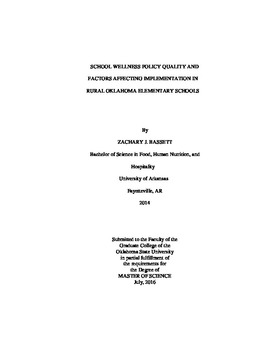| dc.contributor.advisor | Hildebrand, Deana | |
| dc.contributor.author | Bassett, Zachary James | |
| dc.date.accessioned | 2017-02-22T22:13:43Z | |
| dc.date.available | 2017-02-22T22:13:43Z | |
| dc.date.issued | 2016-07-01 | |
| dc.identifier.uri | https://hdl.handle.net/11244/49040 | |
| dc.description.abstract | School districts have been required to develop a school wellness policy (SWP) since the Child Nutrition and WIC Reauthorization Act of 2004 was passed by Congress. School wellness polices consist of objectives for addressing nutrition, physical activity/education, policy implementation, and wellness promotion within the school. Little is known about the factors that influence SWP implementation. The purpose of this study was to investigate correlations between school wellness policy quality (measured by the WellSAT 2.0) and policy implementation (measured by the WellSAT-I). The WellSAT 2.0 is an assessment tool used to grade SWPs based on components that should be included in policies. The WellSAT-I is a pilot implementation assessment tool which consists of interviews and observations of the school site. Both tools result in scores ranging from 0 to 100%. To assess the effect of academic and administrative factors on SWP implementation, principals prioritized nine academic and administrative responsibilities. Variables included two policy quality scores (comprehensiveness and strength), two policy implementation scores (scope and mastery) and principals� prioritized responsibilities. Study sites included 15 rural Oklahoma elementary schools who volunteered for participation. Data were analyzed using descriptive statistics and bivariate correlation analysis, specifically Spearman�s rank order correlation. Mean SWP quality scores were 53.3% � 15.87 for comprehensiveness and 27.3% � 11.20 for strength. Mean implementation scores were 79.5% � 8.67 for scope and 60.7% � 9.82 for mastery. The highest prioritized responsibility was school safety and violence (x?=7.87 � 1.13). There was a significant association between SWP strength and implementation mastery scores (r=0.645, p=0.009), and a significant association between implementation mastery score and school safety and violence (r=0.548, p=0.034). School principals that prioritize safe school environments led schools with more extensive implementation of SWP provisions. SWP quality is an indicator of higher implementation scores indicating that school districts should focus on improving their policies. Implementation scores being higher than policy scores suggest that policies require updating in order to reflect actual implementation. Providing schools with high quality policy models along with implementation training and resources may be effective in improving school health environments in rural elementary schools. | |
| dc.format | application/pdf | |
| dc.language | en_US | |
| dc.rights | Copyright is held by the author who has granted the Oklahoma State University Library the non-exclusive right to share this material in its institutional repository. Contact Digital Library Services at lib-dls@okstate.edu or 405-744-9161 for the permission policy on the use, reproduction or distribution of this material. | |
| dc.title | School Wellness Policy Quality and Factors Affecting Implementation in Rural Oklahoma Elementary School | |
| dc.contributor.committeeMember | Gates, Dr. Gail | |
| dc.contributor.committeeMember | Betts, Dr. Nancy | |
| dc.contributor.committeeMember | Hildebrand, Dr. Deana | |
| osu.filename | Bassett_okstate_0664M_14706.pdf | |
| osu.accesstype | Open Access | |
| dc.description.department | Nutritional Science | |
| dc.type.genre | Thesis | |
| dc.type.material | text | |
